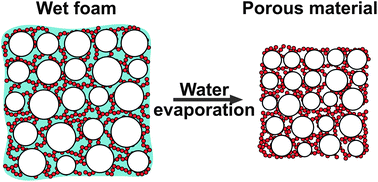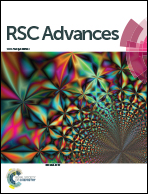Drying of particle-loaded foams for production of porous materials: mechanism and theoretical modeling†
Abstract
Particle-loaded wet foams are appropriate precursors for production of novel porous materials with hierarchical porous structure, ranging from tens of micrometers down to a few nanometers. Such porous materials could be further modified (sintered, impregnated, hydrophobized, etc.) to serve as catalyst supports, porous filters, insulating materials, templates for composite materials, etc. A particular obstacle for the design of such materials is the observed extensive shrinkage during drying of the wet foam precursor. This shrinkage has three important consequences – significant reduction of the size of the final porous material (as compared to the precursor template), significant evolution in the pore size distribution during sample drying, and possible cracking of the material upon drying. The major aims of the current study are (1) to clarify the main mechanism of shrinkage of foams prepared from silica suspensions with high particle concentration, and (2) to describe quantitatively the relation between the properties of the foamed suspension and the final dry porous material obtained from this suspension. The performed experiments and the data interpretation convincingly show that the foamed suspensions shrink until the particle concentration in the foam walls reaches close packing, at which the percolated particle structure is able to resist the high capillary pressures, developed in the process of drying. The volumetric shrinkage of the individual bubbles was found to be equal to that of the macroscopic foam sample. Equations are derived and verified to relate the particle concentration and the bubble fraction in the foam precursor with the final mass density of the obtained porous material and with the degree of shrinkage in the drying process. Three stages of foam drying and shrinking were observed: (1) an induction period with no sample shrinkage, despite the water loss, (2) rapid shrinkage, and (3) final water evaporation at constant volume of the sample. These stages were explained by considering the three basic physical regimes of convective drying of porous materials, as defined by Coussot (European Phys. J. B 15 (2000) 557–566). The equations derived in the current study allow one to design in advance the foam precursors needed to obtain a dry porous material with desired properties.


 Please wait while we load your content...
Please wait while we load your content...